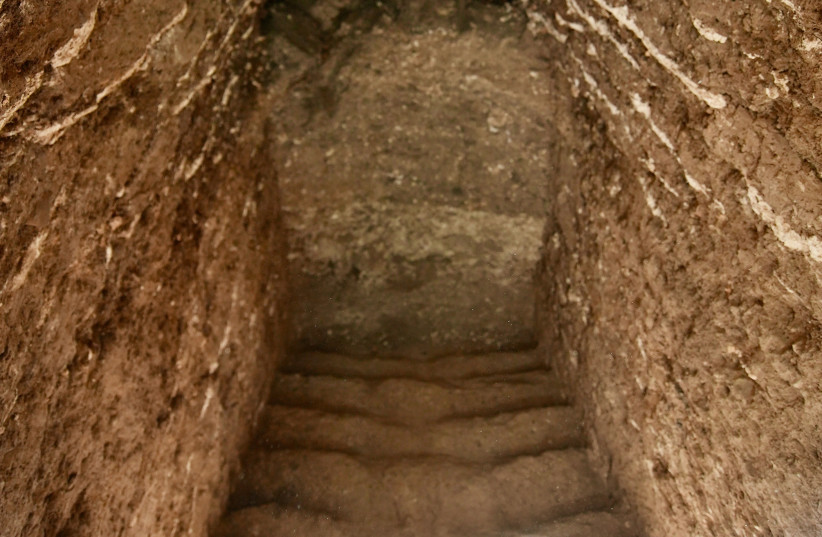Archaeologists at the Tel Shimron excavations in the Jezreel Valley in northern Israel have uncovered a rare and exquisitely preserved vaulted passageway from about 3,800 years ago. This remarkable find represents the first use of a corbelled mudbrick vault in a passageway in the southern Levant, providing a key missing link in the history of the arch in the region, according to excavation co-director Daniel Master.
Jewish history began about 4,000 years ago (the 17th century BCE) with the patriarchs – Abraham, his son Isaac, and his grandson Jacob.
Master added that the vault is “an ancestor to the mudbrick radial arch in the gate at Tel Dan and is an extraordinary example of Mesopotamian mudbrick technology.”
In architecture, a corbel is a structural piece of stone, wood or metal jutting from a wall to carry a superincumbent weight like a bracket. It is a technique in which layered bricks are progressively stepped inward to create a gradually narrowing roof, and was commonly used at sites in Mesopotamia. But this is the first time such a mudbrick construction has been found in a passageway in the southern Levant, making it a rare and significant find showing connections across the fertile crescent.
On the southern side of the acropolis of the ancient city, archaeologists at Tel Shimron excavated a tower composed of over 9,000 well-preserved mudbricks and standing more than five meters high. The center of the structure contained a narrow corridor leading to the two-meter-long vaulted mudbrick passageway, which leads down into the city via mudbrick stairs and features a corbelled roof made of unfired brick adorned with white chalk stripes.

MARIO MARTIN, Master’s excavation co-director, added that corbelling is used on small tomb cysts at various sites in the Middle Bronze Age, both in Canaan and the Egyptian Delta. “Yet, a fully preserved mudbrick-built passageway with this type of corbelled vault is without parallel. Such structures, made of unfired mudbrick, almost never survive.”
At the entrance to the passageway, the archaeologists found an intact Middle Bronze Age vessel lying among ashy debris. The complete artifact, known as a “Nahariya Bowl,” is a seven-cupped offering vessel that gets its name from the site in northern Israel where it was first discovered in a cultic context. This find helps to date the tower complex to the Middle Bronze Age, roughly the same period when the kingdom of Tel Shimron (ancient Sham-anu) was powerful enough to reach the attention of the Egyptians, they said.
The tower complex was part of the royal acropolis. The tower itself, with its extensive use of complex brickwork, exemplifies the massive fortifications and elite buildings typical of the large cities of the Bronze Age, as seen in structures uncovered in elite areas from this period at Mesopotamian cities such as Mari and Ur. The excavators have uncovered roughly 500 square meters of the acropolis, with stone foundations and mudbrick constructions artificially elevating the entire precinct by more than four meters.
Artifact at the scene helps archaeologists date passageway
The Tel Shimron passageway was purposely filled in soon after it was constructed. The ancient fill preserved the vault and mudbrick stairs of the passage in almost perfect condition. The entire vaulted passageway is intact, but beyond the edge of the brick tower, the way is blocked by large stones. By the end of the 2023 Tel Shimron summer excavation season, the passage was backfilled to preserve the delicate mudbrick from environmental damage. In future excavation seasons, archaeologists are planning to clear the passageway from the other side to see where it ultimately leads.
THE TEL SHIMRON mound is an immense ruin that dominates the northern Jezreel Valley in Israel, situated along ancient trade routes from the Mediterranean to the Arabian Desert. The ancient city was first mentioned in Egyptian texts from the early second millennium BCE and continued to play a role in a variety of later texts including the Hebrew Bible and the Mishna.
Until 2016, Tel Shimron had never been systematically excavated, and its multi-period history was largely hidden from the world. Over the last seven years, the team led by Master and Martin has started to fill this gap in the history of northern Israel. Already, in five excavation seasons, the expedition has uncovered a fortified city of the Canaanites (1850-1200 BCE), fragments of the Israelite city from the First Temple period (destroyed by Assyria in 734-32 BCE), and a Jewish village of the first centuries of the Common Era.
The Tel Shimron excavation team includes leading experts in all forms of archaeological inquiry from Israel, the US and Europe, working in collaboration with Tel Aviv University’s Institute of Archaeology and Wheaton College in Illinois. The project takes place under license from the Israel Antiquities Authority and INPA, with the support of sponsors from the US. The goal of the excavation is to understand the ancient world, including the world of the Bible, through rigorous archaeological investigation, in order to provide resources for the study of Levantine history and culture over the last five thousand years.
“Tel Shimron National Park is a time capsule capturing 5,000 years of captivating history in the heart of the Jezreel Valley, renowned as one of the most significant tels in Israel."
Dr. Dror Ben Yosef
INPA archaeologist for the northern region Dr. Dror Ben Yosef said: “Tel Shimron National Park is a time capsule capturing 5,000 years of captivating history in the heart of the Jezreel Valley, renowned as one of the most significant tels in Israel. INPA supports and assists the ongoing expedition in their archaeological excavations at the site. It remains closely engaged with the research findings, which yield surprises year after year, and is interested in preserving Tel Shimron as a site open to the public, with its values of heritage, nature and landscapes.”
